Bitcoin
Crypto Inflows Return with $644 Million Boost, Bitcoin Leads

The market is experiencing renewed optimism as crypto inflows reached $644 million last week.
It is a significant reversal after five consecutive weeks of outflows, suggesting a notable change in investor sentiment.
Crypto Inflows Reach $644 Million, Market Sentiment Recovers
The rebound follows a challenging period in which investor sentiment remained cautious, leading to substantial withdrawals from the market. With total assets under management (AUM) rising by 6.3% since March 10, the latest data suggests a decisive shift in market confidence.
According to the latest CoinShares report, Bitcoin emerged as the primary driver of the market recovery. The pioneer crypto attracted $724 million in inflows, effectively ending a five-week outflow streak totaling $5.4 billion.
The surge in inflows reflects growing investor confidence in Bitcoin, which had previously seen sustained withdrawals amid broader market uncertainty. While Bitcoin saw a strong recovery, the altcoin market experienced a mixed performance.
Ethereum faced the heaviest outflows, with $86 million exiting the asset. On the other hand, Solana recorded $6.4 million in inflows.
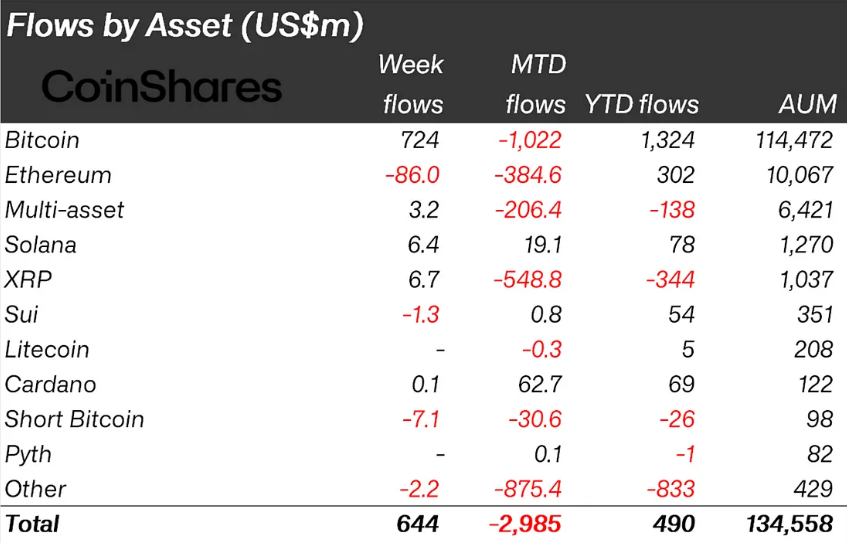
The divergence in altcoin sentiment highlights that investors remain selective about where they allocate capital. Specifically, they focus on projects with perceived strong fundamentals. While the data points to continued investor caution regarding Ethereum (ETH), it also indicates investors see strong potential for Solana (SOL).
Meanwhile, most of last week’s infWeek’ssiginated from the US, which saw $632 million enter digital asset investment products.
March Reverses February’s Negative Trend
The return to inflows follows a difficult February and early March, during which crypto outflows surged. A week prior, crypto outflows totaled $1.7 billion, with Bitcoin withstanding the worst withdrawals.
Before that, outflows hit $876 million, led by US investors offloading digital assets amid a bearish trend. Therefore, the latest influx of capital suggests that sentiment may be turning, possibly driven by renewed institutional interest and a more stable macroeconomic outlook.
Further reinforcing the market’s rebound, Bitcoin ETFs (exchange-traded funds) also saw a strong influx of capital. After five consecutive weeks of outflows, Bitcoin ETFs recorded $744 million in inflows last week. This signals increased institutional participation.
The recovery aligns with Bitcoin’s broader market resurgence and suggests that investors are regaining confidence in crypto-based financial products.
“I bet BTC hits $110,000 before it retests $76,500. Why? The Fed is going from QT to QE for treasuries. And tariffs don’t matter cause transitory inflation,” wrote BitMex founder Arthur Hayes.
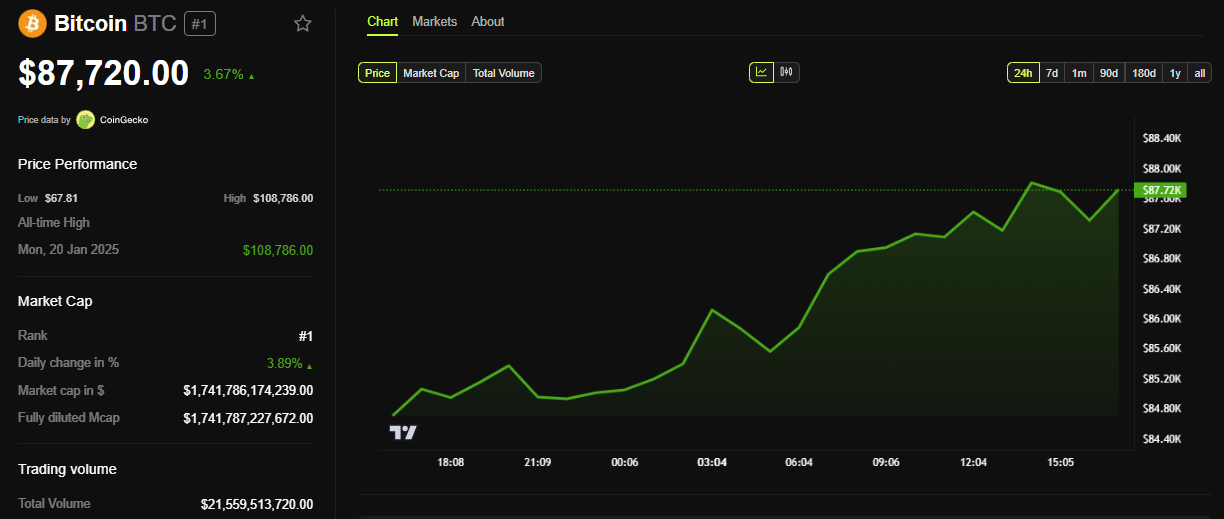
Meanwhile, BeInCrypto data shows BTC was trading for $87,720 as of this writing. This represents a surge of almost 4% in the last 24 hours, with the pioneer crypto steadily edging toward the $90,000 psychological level.
“Bitcoin rose above $87,000 on Monday, its highest since March 7, after dipping to $76,000 earlier this month. The rally comes as reports suggest upcoming Trump tariffs, set for April 2, will be more targeted and less disruptive than feared,” finance expert Walter Bloomberg observed.
The upcoming Trump tariffs, set for April 2 and dubbed “Liberation Day,” are expected to be less disruptive than anticipated. This could boost investor confidence in riskier assets like Bitcoin. The White House’s plan for reciprocal tariffs aims to equalize trade barriers, with Trump emphasizing no exceptions but offering unspecified “flexibility” for certain nations.
Disclaimer
In adherence to the Trust Project guidelines, BeInCrypto is committed to unbiased, transparent reporting. This news article aims to provide accurate, timely information. However, readers are advised to verify facts independently and consult with a professional before making any decisions based on this content. Please note that our Terms and Conditions, Privacy Policy, and Disclaimers have been updated.
Bitcoin
Is Bitcoin the Solution to Managing US Debt? VanEck Explains

Matthew Sigel, Head of Digital Assets Research at VanEck, has proposed a new financial instrument, “BitBonds,” to help manage the US government’s looming $14 trillion refinancing debt requirement.
The 10-year financial instrument combines traditional US Treasury bonds with Bitcoin (BTC) exposure. This offers a potential solution to the nation’s fiscal concerns.
Can Bitcoin-Backed Bonds Help Solve the US Debt Crisis?
According to Sigel’s proposal, BitBonds’ investment structure allocates 90% of the funds to low-risk US Treasury securities and 10% to Bitcoin, combining stability with the potential for higher returns. Additionally, the government would purchase Bitcoin with proceeds from the bond sale.
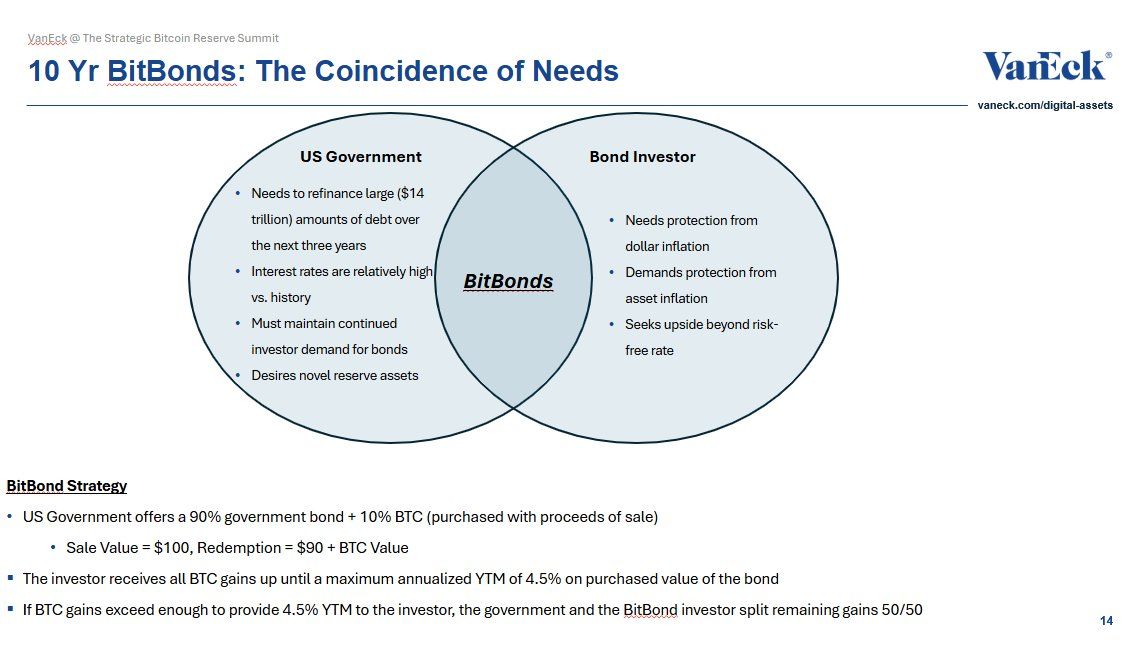
Investors would receive all Bitcoin gains up to a maximum annualized yield-to-maturity of 4.5%. Furthermore, the investor and the government would split any additional gains equally.
“An aligned solution for mismatched incentives,” Sigel remarked.
From an investor perspective, Sigel highlighted that the bond offers a breakeven Bitcoin compound annual growth rate (CAGR) between 8% and 17%, depending on the coupon rate. Additionally, investors’ returns could skyrocket if Bitcoin grows at a 30%–50% CAGR.
“A convex bet—if you believe in Bitcoin,” he added.
However, the structure is not without risks: investors bear Bitcoin’s downside while only partially participating in its upside. Lower-coupon bonds may lose appeal if Bitcoin underperforms.
Meanwhile, the Treasury’s downside is limited. Even a complete collapse of Bitcoin’s value would still result in cost savings compared to traditional bond issuance. Yet, this is contingent on the coupon remaining below the breakeven threshold.
“BTC upside just sweetens the deal. Worst case: cheap funding. Best case: long-vol exposure to the hardest asset on Earth,” Sigel stated.
Sigel claimed that this hybrid approach aligns the interests of the government and investors over a 10-year period. The government faces high interest rates and significant debt refinancing needs. Meanwhile, investors seek protection from inflation and asset debasement.
The proposal comes amid growing concerns over the US debt crisis, exacerbated by the recent increase in the debt ceiling to $36.2 trillion, as reported by BeInCrypto. Notably, the Bitcoin Policy Institute (BPI) has also endorsed the concept.
“Building on President Donald J. Trump’s March 6, 2025, Executive Order establishing the Strategic Bitcoin Reserve, this white paper proposes that the United States adopt Bitcoin-Enhanced US Treasury Bonds (“₿ Bonds” or “BitBonds”) as an innovative fiscal tool to address multiple critical objectives,” the brief read.
In the paper, co-authors Andrew Hohns and Matthew Pines suggested that issuing $2 trillion in BitBonds at a 1% interest rate could cover 20% of the Treasury’s 2025 refinancing needs.
“Over a ten-year period, this represents nominal savings of $700 billion and a present value of $554.4 billion,” the authors wrote.
BPI estimates that if Bitcoin achieves a CAGR of 36.6%, the upside could potentially defease up to $50.8 trillion of federal debt by 2045.
These recommendations are part of broader conversations regarding Bitcoin’s potential impact on national finance. Previously, Senator Cynthia Lummis argued that a US Strategic Bitcoin Reserve could halve the national debt. In fact, VanEck’s analysis indicated that such a reserve could help reduce $21 trillion of debt by 2049.
Disclaimer
In adherence to the Trust Project guidelines, BeInCrypto is committed to unbiased, transparent reporting. This news article aims to provide accurate, timely information. However, readers are advised to verify facts independently and consult with a professional before making any decisions based on this content. Please note that our Terms and Conditions, Privacy Policy, and Disclaimers have been updated.
Bitcoin
Bitcoin Adoption Grows As Public Firms Raise Holdings In Q1


Public companies have added nearly 100,000 Bitcoin to their balance sheets during the first quarter of 2025, pushing total corporate Bitcoin holdings to a staggering 688,000 BTC worth $56.7 billion. According to data from crypto fund issuer Bitwise, this represents a 16% increase in total crypto holdings by publicly traded companies.
12 New Corporate Buyers Enter The Market
The Bitcoin buying spree wasn’t limited to existing crypto investors. Twelve public companies purchased Bitcoin for the first time during Q1, bringing the total number of Bitcoin-holding public firms to 79.
Hong Kong construction firm Ming Shing led new buyers, with its subsidiary Lead Benefit acquiring 833 BTC through two separate purchases – an initial 500 BTC buy in January followed by 333 BTC in February.
Video platform Rumble ranked as the second-largest new buyer, adding 188 BTC to its treasury in mid-March. In a move that stunned market watchers, Hong Kong investment firm HK Asia Holdings Limited purchased just one Bitcoin in February – a modest investment that still caused its share price to almost double in a single day of trading.
Companies are buying bitcoin, Q1 2025 edition. pic.twitter.com/qZc62N8vu5
— Bitwise (@BitwiseInvest) April 14, 2025
Japanese Firm Acquires At A Discount
While new entrants made headlines, existing Bitcoin holders also strengthened their positions. Japanese investment firm Metaplanet announced on April 14 that it had purchased an additional 319 BTC at an average price of 11.8 million yen (about $82,770) per coin.
This latest purchase brings Metaplanet’s total Bitcoin holdings to 4,525 BTC, currently valued at approximately $383.2 million. The company has spent nearly $406 million (58.145 billion yen) building its crypto stack.
Based on current holdings, Metaplanet now ranks as the 10th largest public company crypto holder worldwide, sitting behind Jack Dorsey’s Block, Inc., which holds 8,480 BTC.
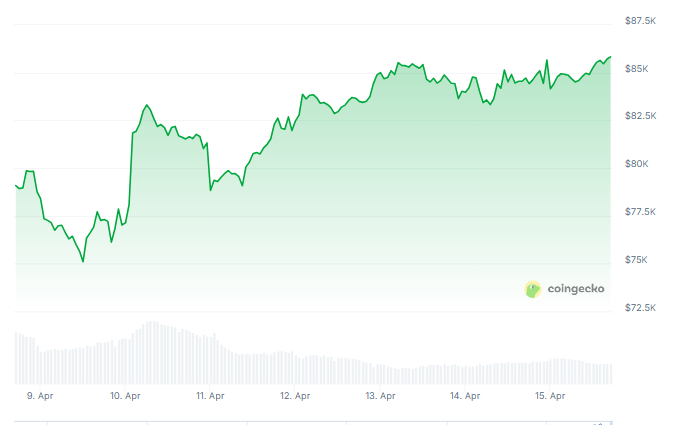
BTC reclaiming the green zone in the last week. Source: Coingecko
Bitcoin Price Recovers After Brief Slump
Bitcoin trades at around $85,787 as of April 15, showing a decent performance over the past 24 hours according to CoinGecko data. The cryptocurrency has gained roughly 2.5% since the end of Q1 on March 31.
The price has bounced back from a brief drop below $75,000 on April 7. That temporary decline came after a broader market selloff triggered by a new round of global tariffs announced by US President Donald Trump.
The growing corporate interest in the top crypto comes as more companies look to diversify their treasury holdings. The combined value of public companies’ Bitcoin rose about 2.3% during the first quarter, reaching nearly $57 billion with BTC priced at $82,400 by quarter’s end.
Featured image from Crews Bank, chart from TradingView

Editorial Process for bitcoinist is centered on delivering thoroughly researched, accurate, and unbiased content. We uphold strict sourcing standards, and each page undergoes diligent review by our team of top technology experts and seasoned editors. This process ensures the integrity, relevance, and value of our content for our readers.
Bitcoin
Bolivia Reverses Crypto-for-Fuel Plan Amid Energy Crisis


Bolivia’s Ministry of Trade and Imports has rejected a state-backed plan to use cryptocurrency for fuel imports.
This move, which marks a stunning policy reversal, signals a retreat from the government’s recent push to adopt digital assets as a workaround for dollar shortages.
Bolivia Rejects Crypto-for-Fuel Scheme Amid Energy Sector Turmoil
The initial plan, announced in March by Bolivia’s state-owned energy giant YPFB, aimed to use crypto to secure fuel imports. This was in response to acute shortages of both US dollars and refined fuel.
As reported by Reuters on March 13, the proposal had received government backing at the time.
But in a statement released Tuesday, Director of Trade and Imports Marcos Duran clarified that YPFB will not be permitted to use crypto for international transactions.
“YPFB must use Bolivia’s own resources and dollar-based financial transfers,” Duran said.
Head of digital assets at VanEck, Mathew Sigel, labels this a clear U-turn on crypto policy.
“U-Turn: Bolivia appears to back away from its crypto-for-fuel scheme,” Sigel quipped.
Disclaimer
In adherence to the Trust Project guidelines, BeInCrypto is committed to unbiased, transparent reporting. This news article aims to provide accurate, timely information. However, readers are advised to verify facts independently and consult with a professional before making any decisions based on this content. Please note that our Terms and Conditions, Privacy Policy, and Disclaimers have been updated.
-

 Market22 hours ago
Market22 hours agoCan Pi Network Avoid a Similar Fate?
-

 Altcoin17 hours ago
Altcoin17 hours agoWhispers Of Insider Selling As Mantra DAO Relocates Nearly $27 Million In OM To Binance
-

 Bitcoin23 hours ago
Bitcoin23 hours agoBitcoin Poised for Summer Rally as Gold Leads and Liquidity Peaks
-
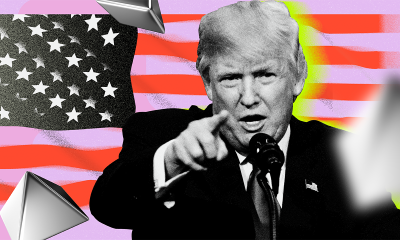
 Market16 hours ago
Market16 hours agoTrump Family Plans Crypto Game Inspired by Monopoly
-

 Altcoin22 hours ago
Altcoin22 hours agoBinance Delists This Crypto Causing 40% Price Crash, Here’s All
-

 Market21 hours ago
Market21 hours agoEthereum Price Consolidation Hints at Strength—Is a Move Higher Coming?
-

 Market18 hours ago
Market18 hours agoXRP Early Investors Continue To Sell As Price Holds Above $2
-

 Market17 hours ago
Market17 hours agoForget XRP At $3, Analyst Reveals How High Price Will Be In A Few Months

























